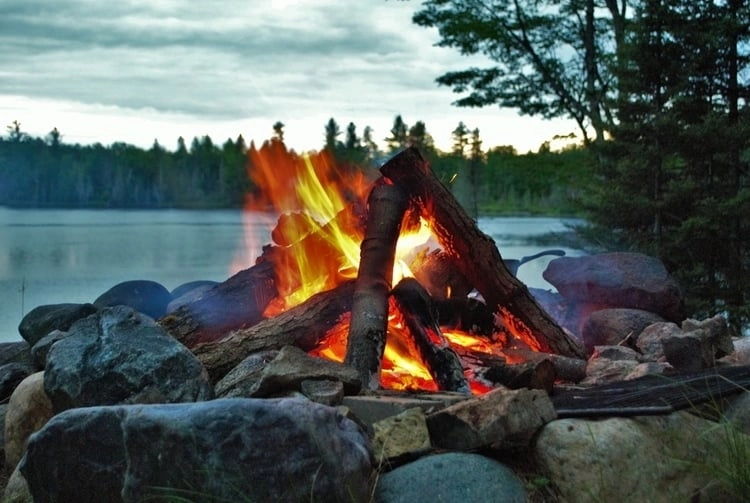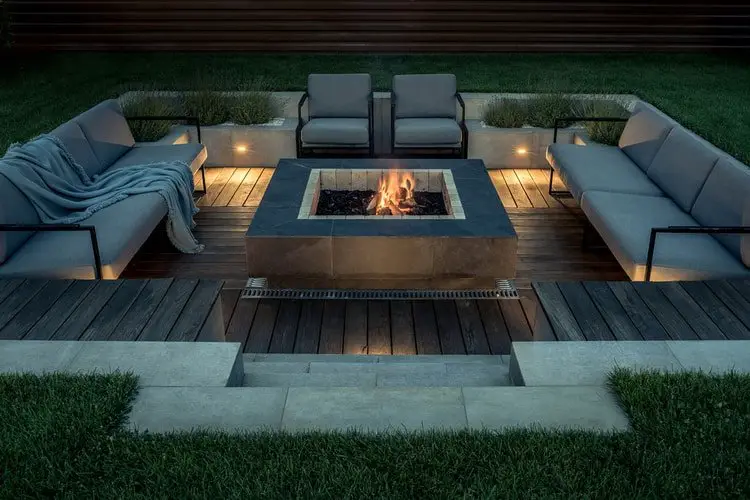People have been building fires for tens of thousands of years, probably longer. Nothing brings people together in a more wholesome or enjoyable way than sitting around a crackling fire. But if you want regular access to the comforting heat and light of an outdoor fire, you need the right backyard fire pit.
Backyard fire pits are more popular than ever in recent years. Fire pits come in all shapes and sizes – popular styles include fire bowls, square, rectangle, or round. To decide on shape and size consider where the fire pit will be placed and how much space you have around it. Also factor in how it will complement the seating around it.
They can be made from a variety of materials including stone, brick, concrete, copper, steel, or metal as long as the interior has heat-resistant material. Fire pits can be portable or built-in permanent structures depending on what makes the most sense in your space.
Another key decision is whether to use a natural gas-powered pit or a wood-burning pit? Each has its pros and cons, but one is probably a better fit for your home and lifestyle.
View this post on Instagram
Gas vs Wood Fire Pits: Pros & Cons
Gas Firepits
Cost: $1,000 to $4,000
Pros
- Clean-burning gas
- Easy to light
- Less cleanup
- Continuous running
- Reduced fire hazards
Cons
- Costs more
- Gas lines can be a hazard
- Fuel tanks need storage
- Fuel tanks can be dangerous
- Longer installation
- More expensive installation
Wood Burning Firepits
Cost: $50 to $1,500
Pros
- Less expensive
- Easier to install
- Romantic experience
- Provides more heat
Cons
- Produces soot and smoke
- Fire-starting is more involved
- Requires wood storage
- More difficult to light
- More cleaning
- Can be a fire hazard or subject to fire bans
Access to Gas or Wood
For a gas fire pit, the biggest factor is whether you have natural gas hookups, or if natural gas is available in your area to make a gas fire pit feasible. If not, propane would still be an option, but some people will shy away from it for various reasons.
If natural gas is available in your location, but you don’t have hookups, you’ll need to contact your local utilities to have a line installed. There may be a fee for the installation, and the line will cost between $12 and $25 per foot. Some utility companies will give you a nice discount if you agree to subscribe to their service for a given amount of time.
Alternatively, you can power your gas-lit fire pit with propane. This requires you to replace the propane tank periodically. You will also need to take the time to learn to use it safely, but it’s easy to do. Aside from that consideration, propane is efficient, clean-burning, and affordable to use, just like natural gas.
For wood, consider the access to get firewood in your area or whether you can have it delivered. You’ll also need to consider wood storage at your home and keeping wood dry through rain or snow seasons. Before installing or buying a fire pit, check with your local fire department on any ordinances about having fires at your home.

Wood Burning Fire Pits
The most wonderful thing about a wood-burning fire pit is that anyone can have one for next to no cost. If the frills are not important to you, you can simply dig a hole, line it with heavy stones, and build a campfire in it. If you want to get started right away and you’re a handy type, you can make your own fire pit.
However, for a bit more of an investment, you can have a portable or permanent fire pit that will last for years, and provide many hours of enjoyment.
A good, old-fashioned wood-burning firepit will deliver the wonderful sounds, smells, and flickering firelight that everyone naturally loves. Another advantage of wood-burning fire pits is that wood burns hotter so it provides more heat. If you have cold evenings and staying warm is a factor to enjoying the outdoors, that might be a consideration.
Some downsides of a wood-burning fire include the potential fire hazard with flying sparks and the smoky smell that you might get from sitting next to one. Some models come with a screen top that minimizes sparks. Cleanup can be a little messier too which might be a factor to consider, especially if you want to keep your firepit looking nice. It’s also more work and effort to build, light, and maintain the fire. But if you enjoy fire-building, then there is nothing that beats the naturalistic beauty and romance of a real, wood fire.
Solo stoves have surged in popularity in recent years due to their unique design that maximizes airflow and allows for a nearly smokeless fire. They are popular on back decks and in smaller spaces where a roaring bonfire might not be practical.
Gas Fire Pits
Gas-powered fire pits are not without their own charms and certainly win for convenience. The most significant difference between the experience of using a wood pit and a gas pit is the quality of the flame. With natural gas or propane, you get a seemingly magical flame rising strong and steady from a pile of porous, volcanic ricks. It creates a lovely atmosphere and will warm you and your company just as nicely as a wood fire. But it is somewhat tamer in its effect than a roaring wood fire and provides less of a heat source.
Gas fire pits also produce zero soot and so little smoke that you cannot perceive it. That means it will not need cleaning very often, if ever. It’s also nicer for anyone who may be sensitive to smoke, and you don’t have to worry about breathing the smoke in since it’s practically non-existent.
Because they are extremely easy to light, you are likely to spend more time using one than you would use a wood pit. Simply walk outside, turn on the gas, and light the burner. you’ll probably find yourself using a gas pit almost every night It’s a wonderful way to unplug and relax.
Of course, gas-powered fire pits are considerably more expensive. If you do go this route, it’s wise to mark the gas line to avoid breaking it by mistake. Alternatively, you can build a stone path over the line to protect and mark its location.
Which to Choose?
At the end of the day, both types of fire pit are wonderful and have their pros and cons. Some homes might opt for both – a gas pit around a table or outdoor living room and a fire pit further into the yard or garden for a crackling bonfire.
But whatever you choose, a backyard fire pit will bring the household together and give you many hours of relaxation. Unplug and enjoy family meals around a roaring fire, invite friends over, or just gaze at the stars with the comfort of flickering light and natural heat.
No matter which type you choose, you’ll never regret getting a backyard firepit and the hours of enjoyment that it brings.

